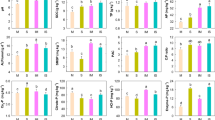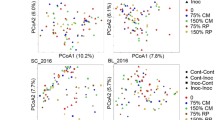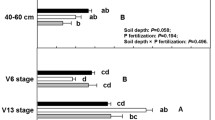Abstract
Background and aims
Positive below-ground interactions (facilitation) should be more pronounced when resources limit crop growth, according to the stress-gradient hypothesis. Our aim was to test this hypothesis for intercropped durum wheat and faba bean along a P-fertilizer gradient.
Methods
A field experiment was conducted in a long-term P-fertilizer trial with three rates of P-fertilization (No, Low and High P). Microbial biomass was assessed by chloroform fumigation-extraction. Quantitative PCR was applied to evaluate the abundance of relevant microbial groups.
Results
Phosphorus availability and microbial biomass systematically increased in the rhizosphere compared to bulk soil. P-fertilization resulted in higher abundance of targeted bacterial phyla, whole bacterial and fungal communities, and depressed mycorrhizal colonization of durum wheat, but not faba bean. Microbial biomass carbon significantly increased in the rhizosphere only in P-fertilized treatments, pointing to P limitation of microbial communities. Intercropping yielded a significant effect on rhizosphere microbial properties only at High P. Microbial biomass P increased in the rhizosphere of intercropped faba bean only at No P level, and was thus the sole finding supporting the stress-gradient hypothesis.
Conclusions
P-fertilization was the main driver of microbial communities in this field trial, and P-fertilizer application modulated the species-specific effect in the intercrop. Plant performance did not validate the stress-gradient hypothesis as positive plant-plant interactions occurred regardless of the level of P-fertilization.






Similar content being viewed by others
References
Ayaga G, Todd A, Brookes P (2006) Enhanced biological cycling of phosphorus increases its availability to crops in low-input sub-Saharan farming systems. Soil Biol Biochem 38:81–90
Bainard L, Koch A, Gordon A, Klironomos J (2013) Growth response of crops to soil microbial communities from conventional monocropping and tree-based intercropping systems. Plant Soil 363:345–356
Betencourt E, Duputel M, Colomb B, Desclaux D, Hinsinger P (2012) Intercropping promotes the ability of durum wheat and chickpea to increase rhizosphere phosphorus availability in a low P soil. Soil Biol Biochem 46:181–190
Brookes P, Powlson D, Jenkinson D (1982) Measurement of microbial biomass phosphorus in soil. Soil Biol Biochem 14:319–329
Brookes P, Powlson D, Jenkinson D (1984) Phosphorus in the soil microbial biomass. Soil Biol Biochem 16:169–175
Callaway RM (2007) Positive interactions and interdependence in plant communities. Springer, Berlin
Carpenter SR (2005) Eutrophication of aquatic ecosystems: Bistability and soil phosphorus. Proc Natl Acad Sci U S A 102:10002–10005
Chessel D, Dufour AB, Thioulouse J (2004) The ade4 package-I-one-table methods. R news 4:5–10
Colomb B, Debaeke P, Jouany C, Nolot JM (2007) Phosphorus management in low input stockless cropping systems: crop and soil responses to contrasting P regimes in a 36-year experiment in southern France. Eur J Agron 26:154–165
Cordell D, Drangert J-O, White S (2009) The story of phosphorus: global food security and food for thought. Glob Environ Chang 19:292–305
Covacevich F, Marino MA, Echeverría HE (2006) The phosphorus source determines the arbuscular mycorrhizal potential and the native mycorrhizal colonization of tall fescue and wheatgrass. EurJ Soil Biol 42:127–138
Dawson CJ, Hilton J (2011) Fertiliser availability in a resource-limited world: production and recycling of nitrogen and phosphorus. Food Policy 36:14–S22
De Wit DC, Bergh VDJ (1965) Competition between herbage plants. J Agric Sci 13:212–221
Demsar J (2006) Statistical comparisons of classifiers over multiple data sets. J Mach Learn Res 7:1–30
Devau N, Le Cadre E, Hinsinger P, Gérard F (2010) A mechanistic model for understanding root-induced chemical changes controlling phosphorus availability. Ann Bot 105:1183–1197
Devau N, Hinsinger P, Le Cadre E, Gérard F (2011) Root-induced processes controlling phosphate availability in soils with contrasted P-fertilized treatments. Plant Soil 348:1–16
Fierer N, Jackson JA, Vilgalys R, Jackson RB (2005) Assessment of soil microbial community structure by use of taxon-specific quantitative PCR assays. Appl Environ Microbiol 71:4117–4120
Fridley J (2002) Resource availability dominates and alters the relationship between species diversity and ecosystem productivity in experimental plant communities. Oecologia 132:271–277
Hauggaard-Nielsen H, Gooding M, Ambus P, Corre-Hellou G, Crozat Y, Dahlmann C, Dibet A, von Fragstein P, Pristeri A, Monti M, Jensen ES (2009) Pea–barley intercropping for efficient symbiotic N2-fixation, soil N acquisition and use of other nutrients in European organic cropping systems. Field Crop Res 113:64–71
He Q, Bertness MD, Altieri AH, Vila M (2013a) Global shifts towards positive species interactions with increasing environmental stress. Ecol Lett 16:695–706
He Y, Ding N, Shi J, Wu M, Liao H, Xu J (2013b) Profiling of microbial PLFAs: implications for interspecific interactions due to intercropping which increase phosphorus uptake in phosphorus limited acidic soils. Soil Biol Biochem 57:625–634
Heuck C, Weig A, Spohn M (2015) Soil microbial biomass C: N: P stoichiometry and microbial use of organic phosphorus. Soil Biol Biochem 85:119–129
Hinsinger P, Betencourt E, Bernard L, Brauman A, Plassard C, Shen J, Tang X, Zhang F (2011a) P for two, sharing a scarce resource: soil phosphorus acquisition in the rhizosphere of intercropped species. Plant Physiol 156:1078–1086
Hinsinger P, Brauman A, Devau N, Gérard F, Jourdan C, Laclau J-P, Le Cadre E, Jaillard B, Plassard C (2011b) Acquisition of phosphorus and other poorly mobile nutrients by roots. Where do plant nutrition models fail? Plant Soil 348:29–61
Hu J, Lin X, Wang J, Dai J, Cui X, Chen R, Zhang J (2009) Arbuscular mycorrhizal fungus enhances crop yield and P-uptake of maize (Zea mays L.): a field case study on a sandy loam soil as affected by long-term P-deficiency fertilization. Soil Biol Biochem 41:2460–2465
Jansson M, Bergström AK, Lymer D, Vrede K, Karlsson J (2006) Bacterioplankton growth and nutrient use efficiencies under variable organic carbon and inorganic phosphorus ratios. Microb Ecol 52:358–364
Jenkinson D (2004) Measuring soil microbial biomass. Soil Biol Biochem 36:5–7
Jones DL, Nguyen C, Finlay RD (2009) Carbon flow in the rhizosphere: carbon trading at the soil-root interface. Plant Soil 321:5–33
Jorquera MA, Crowley DE, Marschner P, Greiner R, Fernández MT, Romero D, Menezes-Blackburn D, La Luz D, Mora M (2011) Identification of β-propeller phytase-encoding genes in culturable Paenibacillus and Bacillus spp. from the rhizosphere of pasture plants on volcanic soils. FEMS Microbiol Ecol 75:163–172
Kucey R (1983) Phosphate-solubilizing bacteria and fungi in various cultivated and virgin Alberta soils. Can J Soil Sci 63:671–678
Le Roux PC, McGeoch MA (2010) Interaction intensity and importance along two stress gradients: adding shape to the stress-gradient hypothesis. Oecologia 162:733–745
Lenth R (2013) Lsmeans: least-squares means. R package version 1:06–05
Li L, Sun J, Zhang F, Li X, Rengel Z, Yang S (2001) Wheat/maize or wheat/soybean strip intercropping: II. Recovery or compensation of maize and soybean after wheat harvesting. Field Crop Res 71:173–181
Li L, Zhang F, Li X, Christie P, Sun J, Yang S, Tang C (2003) Interspecific facilitation of nutrient uptake by intercropped maize and faba bean. Nutr Cycl Agroecosyst 65:61–71
Li L, Li S, Sun J, Zhou L, Bao X, Zhang H, Zhang F (2007) Diversity enhances agricultural productivity via rhizosphere phosphorus facilitation on phosphorus-deficient soils. Proc Natl Acad Sci U S A 104:11192–11196
Li H, Shen J, Zhang F, Marschner P, Cawthray G, Rengel Z (2010) Phosphorus uptake and rhizosphere properties of intercropped and monocropped maize, faba bean, and white lupin in acidic soil. Biol Fertil Soils 46:79–91
Li CJ, Dong Y, Li HG, Shen JB, Zhang FS (2016) Shift from complementarity to facilitation on P uptake by intercropped wheat neighboring with faba bean when available soil P is depleted. Sci Rep 6. doi:10.1038/srep18663
Liu Y, Shi G, Mao L, Cheng G, Jiang S, Ma X, An L, Du G, Johnson NC, Feng H (2012) Direct and indirect influences of 8 yr of nitrogen and phosphorus fertilization on Glomeromycota in an alpine meadow ecosystem. New Phytol 194:523–535
Liu Y, Johnson C, Mao L, Shi G, Jiang S, Ma X, Du G, An L, Feng H (2015) Phylogenetic structure of arbuscular mycorrhizal community shifts in response to increasing soil fertility. Soil Biol Biochem 89:196–205
Loreau M (2001) Biodiversity and ecosystem functioning: current knowledge and future challenges. Science 294:804–808
Maestre FT, Callaway RM, Valladares F, Lortie CJ (2009) Refining the stress-gradient hypothesis for competition and facilitation in plant communities. J Ecol 97:199–205
Mander C, Wakelin S, Young S, Condron L, O’Callaghan M (2012) Incidence and diversity of phosphate-solubilising bacteria are linked to phosphorus status in grassland soils. Soil Biol Biochem 44:93–101
Marschner P, Hatam Z, Cavagnaro TR (2015) Soil respiration, microbial biomass and nutrient availability after the second amendment are influenced by legacy effects of prior residue addition. Soil Biol Biochem 88:169–177
Nemenyi P (1963) Distribution-free Multiple Comparisons. Ph.D. thesis, Princeton University
Ngosong C, Jarosch M, Raupp J, Neumann E, Ruess L (2010) The impact of farming practice on soil microorganisms and arbuscular mycorrhizal fungi: crop type versus long-term mineral and organic fertilization. Appl Soil Ecol 46:134–142
Ohno T, Zibilske LM (1991) Determination of low concentrations of phosphorus in soil extracts using malachite green. Soil Sci Soc Am J 55:892–895
Olsen SR, Cole C, Watanabe FS, Dean L (1954) Estimation of available phosphorus in soils by extraction with sodium bicarbonate. USDA Circular 939. U.S. Government Printing Office, Washington, DC
Penuelas J, Poulter B, Sardans J, Ciais P, van der Velde M, Bopp L, Boucher O, Godderis Y, Hinsinger P, Llusia J, Nardin E, Vicca S, Obersteiner M, Janssens IA (2013) Human-induced nitrogen-phosphorus imbalances alter natural and managed ecosystems across the globe. Nat Commun 4:2934
Philippot L, Raaijmakers JM, Lemanceau P, van der Putten WH (2013) Going back to the roots: the microbial ecology of the rhizosphere. Nat Rev Microbiol 11:789–799
Pinheiro J, Bates D (2000) Mixed-effects models in S and S-PLUS. Springer-Verlag, New York
Pinheiro J, Bates D, DebRoy S, Sarkar D, the R Development Core Team (2013) Nlme: linear and nonlinear mixed effects models. R package version 3:1–111
Plenchette C, Fortin J, Furlan V (1983) Growth responses of several plant species to mycorrhizae in a soil of moderate P-fertility. Plant Soil 70:199–209
Pohlert T (2016) The pairwise multiple comparison of mean ranks package (PMCMR). R package. http://CRAN.R-project.org/package=PMCMR
Raghothama K (1999) Phosphate acquisition. Annu Rev Plant Biol 50:665–693
Richardson AE, Simpson RJ (2011) Soil microorganisms mediating phosphorus availability update on microbial phosphorus. Plant Physiol 156:989–996
Song Y, Marschner P, Li L, Bao X, Sun J, Zhang F (2007a) Community composition of ammonia-oxidizing bacteria in the rhizosphere of intercropped wheat (Triticum aestivum L.), maize (Zea mays L.), and faba bean (Vicia faba L.). Biol Fertil Soils 44:307–314
Song Y, Zhang F, Marschner P, Fan F, Gao H, Bao X, Sun J, Li L (2007b) Effect of intercropping on crop yield and chemical and microbiological properties in rhizosphere of wheat (Triticum aestivum L.), maize (Zea mays L.), and faba bean (Vicia faba L.). Biol Fertil Soils 43:565–574
Spohn M (2015) Microbial respiration per unit microbial biomass depends on litter layer carbon-to-nitrogen ratio. Biogeosciences 12:817–823
Spohn M, Kuzyakov Y (2013) Phosphorus mineralization can be driven by microbial need for carbon. Soil Biol Biochem 61:69–75
Sun Y, Zhang N, Wang E, Yuan H, Yang J, Chen W (2009) Influence of intercropping and intercropping plus rhizobial inoculation on microbial activity and community composition in rhizosphere of alfalfa (Medicago sativa L.) and Siberian wild rye (Elymus sibiricus L.). FEMS Microbiol Ecol 70:218–226
Sundqvist MK, Liu Z, Giesler R, Wardle DA (2014) Plant and microbial responses to nitrogen and phosphorus addition across an elevational gradient in subarctic tundra. Ecology 95:1819–1835
Tang X, Bernard L, Brauman A, Daufresne T, Deleporte P, Desclaux D, Souche G, Placella SA, Hinsinger P (2014) Increase in microbial biomass and phosphorus availability in the rhizosphere of intercropped cereal and legumes under field conditions. Soil Biol Biochem 75:86–93
Tilman D (1999) Global environmental impacts of agricultural expansion: the need for sustainable and efficient practices. Proc Natl Acad Sci U S A 96:5995
Tilman D (2001) Forecasting agriculturally driven global environmental change. Science 292:281–284
Tournier E, Amenc L, Pablo AL, Legname E, Blanchart E, Plassard C, Robin A, Bernard L (2015) Modification of a commercial DNA extraction kit for safe and rapid recovery of DNA and RNA simultaneously from soil, without the use of harmful solvents. MethodsX 2:182–191
Trenbath B (1976) Plant interactions in mixed crop communities. In: Papendick IR, Sanchez AP, Triplett BG (eds) Multiple cropping. Amercam Society of Agronomy, Wisconsin, pp. 129–169
Treseder KK (2004) A meta-analysis of mycorrhizal responses to nitrogen, phosphorus, and atmospheric CO2 in field studies. New Phytol 164:347–355
Treseder KK (2013) The extent of mycorrhizal colonization of roots and its influence on plant growth and phosphorus content. Plant Soil 371:1–13
Treseder KK, Allen MF (2000) Mycorrhizal fungi have a potential role in soil carbon storage under elevated CO2 and nitrogen deposition. New Phytol 147:189–200
Trouvelot A, Kough JL, Gianinazzi-Pearson V (1986) Mesure du taux de mycorhization VA d'un systeme radiculaire. Recherche de methodes d'estimation ayant une signification fonctionnelle. In: Physiological and Genetical Aspects of Mycorrhizae. Proceedings of the 1st European Symposium on mycorrhizae (Ed. by V. Gianinazzi-Pearson & S. Gianinazzi). pp 217–221
Vainio EJ, Hantula J (2000) Direct analysis of wood-inhabiting fungi using denaturing gradient gel electrophoresis of amplified ribosomal DNA. Mycol Res 104:927–936
Vance CP (2001) Symbiotic nitrogen fixation and phosphorus acquisition. Plant nutrition in a world of declining renewable resources. Plant Physiol 127:390–397
Vierheilig H, Coughlan AP, Wyss U, Piché Y (1998) Ink and vinegar, a simple staining technique for arbuscular-mycorrhizal fungi. Appl Environ Microbiol 64:5004–5007
Wakelin S, Mander C, Gerard E, Jansa J, Erb A, Young S, Condron L, O’Callaghan M (2012) Response of soil microbial communities to contrasted histories of phosphorus fertilisation in pastures. Appl Soil Ecol 61:40–48
Wang D, Marschner P, Solaiman Z, Rengel Z (2007) Growth, P uptake and rhizosphere properties of intercropped wheat and chickpea in soil amended with iron phosphate or phytate. Soil Biol Biochem 39:249–256
Willey RW (1979a) Intercropping: its importance and research needs. Part 2, agronomy and research approaches. Commonwealth Agricultural Bureaux
Xu X, Thornton PE, Post WM (2013) A global analysis of soil microbial biomass carbon, nitrogen and phosphorus in terrestrial ecosystems. Glob Ecol Biogeogr 22:737–749
Zhang F, Shen J, Zhang J, Zuo Y, Li L, Chen X (2010) Chapter one-rhizosphere processes and management for improving nutrient use efficiency and crop productivity: implications for China. Adv Agron 107:1–32
Acknowledgments
Financial support for the experimental costs was provided by ANR (Agence Nationale de la Recherche) SYSTERRA programme ANR-08-STRA-11 (PerfCom). We thank André Gavaland and his team at UE Auzeville (INRA Toulouse) for technical assistance with the maintenance of the field experiment, Julie Campguilhem at UMR AGIR (INRA Toulouse), Didier Arnal, Philippe Deleporte, Anne-Laure Pablo, Catherine Pernot and Estelle Tournier at UMR Eco&Sols (INRA Montpellier) for technical assistance with sampling and analytical tasks.
Author information
Authors and Affiliations
Corresponding author
Additional information
Responsible Editor: Liesje Mommer.
Rights and permissions
About this article
Cite this article
Tang, X., Placella, S.A., Daydé, F. et al. Phosphorus availability and microbial community in the rhizosphere of intercropped cereal and legume along a P-fertilizer gradient. Plant Soil 407, 119–134 (2016). https://doi.org/10.1007/s11104-016-2949-3
Received:
Accepted:
Published:
Issue Date:
DOI: https://doi.org/10.1007/s11104-016-2949-3




